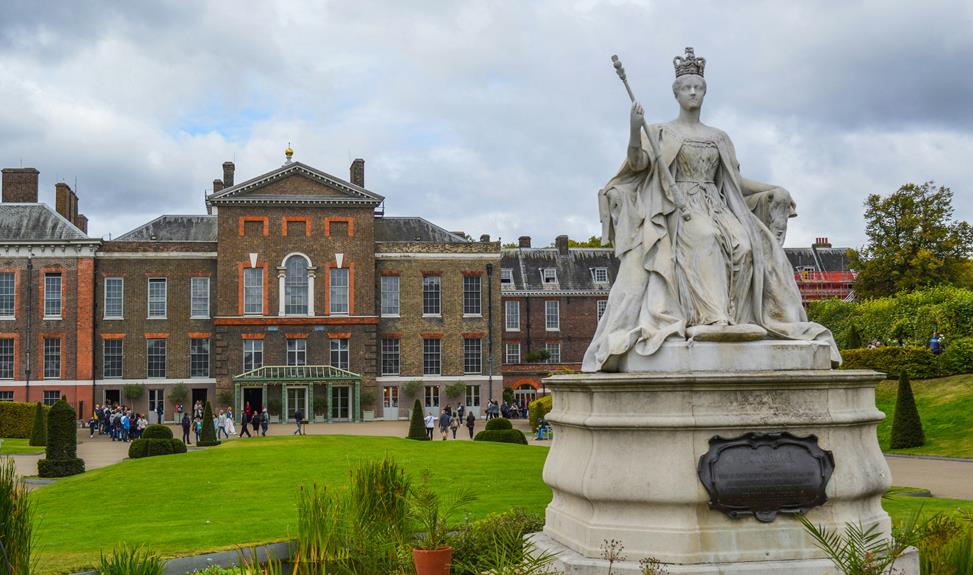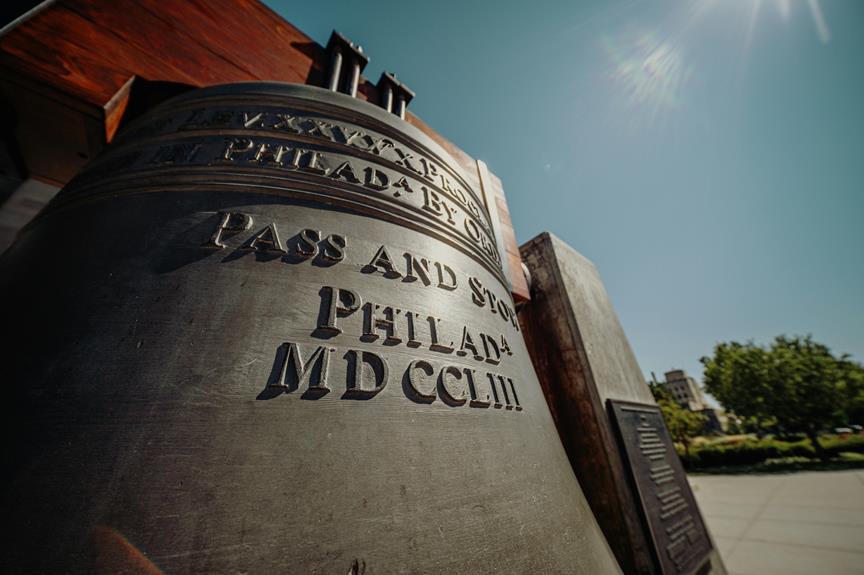The Cenotaph in the UK, a solemn monument steeped in history and significance, commands reverence and contemplation. Its stoic presence on Whitehall prompts reflection on the sacrifices made by countless individuals in service of their country. As a focal point for remembrance, the Cenotaph's architectural grandeur and symbolic weight evoke a sense of duty and gratitude. Beyond its physical form lies a narrative of resilience, honor, and national identity waiting to be unraveled, inviting us to explore the layers of meaning embedded within its stone facade.
Key Takeaways
- Symbol of remembrance for fallen soldiers.
- Neoclassical design with modernist elements.
- Central location in Whitehall, London.
- Annual Poppy Day event honors veterans.
- Wreath-laying ceremonies symbolize remembrance.
Historical Significance
The historical significance of The Cenotaph in the UK lies in its role as a symbol of remembrance and tribute to the fallen soldiers of various conflicts throughout history. This monument holds immense cultural importance as it serves as a focal point for national remembrance, allowing people to come together and honor the sacrifices made by those who fought for freedom and justice. The Cenotaph's historical legacy is deeply intertwined with the nation's wartime past, representing a solemn tribute to the courage and resilience displayed by individuals in times of strife.
Since its inception, The Cenotaph has stood as a poignant reminder of the human cost of war, evoking a sense of collective memory that transcends generations. It serves as a powerful symbol of unity and solidarity, bringing people from all walks of life together to pay their respects and reflect on the tragedies of the past. The monument's timeless design and solemn presence make it a lasting emblem of the nation's commitment to honoring its fallen heroes.
As a wartime tribute, The Cenotaph stands as a declaration to the resilience of the human spirit in the face of adversity. It commemorates the bravery and sacrifice of those who gave their lives in service of their country, ensuring that their memory lives on in the hearts and minds of future generations. The Cenotaph serves as a powerful symbol of remembrance, urging us never to forget the high price of freedom and the enduring legacy of those who fought for it.
Architectural Features
Featuring a striking blend of classical and modern architectural elements, the design of The Cenotaph in the UK showcases a timeless aesthetic that symbolizes solemn remembrance and national unity. The architectural features of The Cenotaph are a proof to the meticulous design elements and construction techniques employed in its creation:
- Neoclassical Influence: The Cenotaph's design draws inspiration from neoclassical architecture, evident in its clean lines, symmetrical structure, and use of Portland stone. These elements evoke a sense of dignity and timelessness, reflecting the solemn purpose of the monument.
- Modernist Approach: Despite its classical influences, The Cenotaph also incorporates modernist design elements, such as its minimalist form and absence of decorative ornamentation. This fusion of classical and modern styles gives the monument a contemporary relevance while maintaining a sense of tradition.
- Precision Engineering: The construction techniques used in building The Cenotaph reflect a commitment to precision and durability. The monument's solid structure and intricate detailing stand as a proof to the skill of the engineers and craftsmen involved in its creation, ensuring its longevity as a symbol of remembrance.
Symbolism and Meaning
Drawing upon a rich tapestry of historical significance and cultural resonance, the symbolism and meaning behind The Cenotaph in the UK encapsulates a profound tribute to sacrifice and national identity. As a symbolic representation of remembrance, The Cenotaph stands as a solemn monument dedicated to honoring the sacrifices of those who lost their lives in conflicts. Its simple and stark design speaks to the gravity of war and the enduring memory of those who served their country.
The Cenotaph holds immense cultural importance as a focal point for national commemorations, including Remembrance Sunday and other significant events. It serves as a tangible link to the past, connecting present generations with the sacrifices of their predecessors. The act of gathering around The Cenotaph during commemorative events fosters a sense of unity and shared remembrance among the diverse populations of the UK.
Moreover, The Cenotaph's symbolic significance extends beyond its physical structure. It represents a collective memory and a shared commitment to never forget the sacrifices made for freedom and democracy. The inscription 'The Glorious Dead' eloquently captures the reverence and gratitude felt towards those who gave their lives in service of their country. In this way, The Cenotaph stands not only as a monument of stone but as a living affirmation to the enduring values of sacrifice, honor, and national unity.
Commemorative Events
Symbolizing a solemn continuity of remembrance and honoring sacrifices, the commemorative events held at The Cenotaph in the UK serve as poignant reminders of the nation's history and collective memory. These events are deeply rooted in tradition and play an important role in paying tribute to the fallen heroes and veterans who have sacrificed for the country.
Here are three key aspects of the commemorative events at The Cenotaph:
- Remembrance Parades: Remembrance parades are a central feature of the commemorative events at The Cenotaph. These parades bring together military personnel, veterans, and the public to honor the memory of those who have served and died in conflicts. The solemn march past the Cenotaph is a poignant moment that symbolizes respect and gratitude for the sacrifices made.
- National Memorials: The Cenotaph serves as a focal point for national memorials and ceremonies in the UK. Events such as Remembrance Sunday and Armistice Day are marked with solemn ceremonies at The Cenotaph, attended by dignitaries, royalty, and the public. These national memorials highlight the importance of remembrance and make sure that the sacrifices of the past are never forgotten.
- Ceremonies: Various ceremonies are held at The Cenotaph throughout the year to commemorate significant events and anniversaries related to military history. These ceremonies often involve laying wreaths, observing moments of silence, and reflecting on the impact of war and conflict. The solemnity of these ceremonies underscores the nation's commitment to honoring its past and those who have served.
Restoration and Maintenance
The ongoing restoration and maintenance efforts at The Cenotaph in the UK are essential for preserving this iconic monument's historical significance and ensuring its structural integrity for future generations. The Cenotaph, erected in Whitehall, London, serves as a central focal point for national remembrance events and ceremonies, making its upkeep crucial.
Repair work on The Cenotaph is meticulously planned and executed to address any signs of wear, weathering, or damage that may compromise its longevity. Preservation efforts include cleaning, repointing of stonework, and regular inspections to detect any structural issues early on. The monument's Portland stone material requires specialized care to combat the effects of pollution, biological growth, and natural aging processes.
The restoration of The Cenotaph is not merely about maintaining its physical condition but also about safeguarding the symbolism it holds for the British people and beyond. The monument stands as a solemn tribute to the sacrifices of those who served in conflicts, and its pristine state is a reflection of the respect and honor attributed to their memory.
Location and Accessibility
Located in the heart of Whitehall, London, The Cenotaph stands as a prominent and accessible site for national remembrance events and ceremonies. The location of The Cenotaph offers visitors easy access through various means of public transport, making it a convenient spot for commemorations and gatherings. Additionally, its central placement in the city allows for a seamless integration into the fabric of London's historical and cultural landmarks.
Accessibility at The Cenotaph:
- Public Transport: The Cenotaph is conveniently located near several public transport options, including Westminster Underground Station and numerous bus routes that pass through Whitehall. This accessibility ensures that visitors can reach the site with ease, promoting inclusivity and participation in events held at The Cenotaph.
- Nearby Attractions: Situated in close proximity to iconic London landmarks such as the Houses of Parliament, Big Ben, and Westminster Abbey, The Cenotaph offers visitors the opportunity to explore additional historical sites after paying their respects. This strategic location enhances the overall experience for individuals visiting The Cenotaph, allowing them to delve deeper into the rich history of the area.
Visitor Experience and Impact
Enhancing the commemorative journey for visitors, The Cenotaph's symbolic significance and historical context greatly contribute to the overall visitor experience and societal impact. The emotional connections forged by visitors with the monument are profound, as they pay their respects to the fallen soldiers and reflect on the sacrifices made during times of conflict. The interactive displays at The Cenotaph provide a deeper insight into the significance of remembrance and allow visitors to engage with the history and stories behind the monument.
| Visitor Experience | Societal Impact |
|---|---|
| – Symbolic significance | – Fosters a sense of unity |
| – Historical context | – Encourages remembrance |
| – Emotional connections | – Promotes understanding |
The symbolic significance of The Cenotaph creates a space for visitors to contemplate the past and present implications of war, fostering a sense of unity among individuals from diverse backgrounds. Through interactive displays, visitors can engage with historical narratives, deepening their understanding of the sacrifices made by servicemen and women. This immersive experience not only enhances visitor engagement but also promotes a culture of remembrance and appreciation for the contributions of those who served their country. The societal impact of The Cenotaph extends beyond individual visitors, resonating with communities and encouraging a collective commitment to honoring the memory of the fallen.
Poppy Day at the Cenotaph
Poppy Day at the Cenotaph serves as a poignant annual event that honors and remembers the sacrifices of veterans and fallen soldiers in a solemn and respectful manner. This day, also known as Remembrance Day, holds significant importance in British culture, commemorating the end of World War I and paying tribute to the veterans' contributions throughout history.
Key Aspects of Poppy Day at the Cenotaph:
- Remembrance Traditions: Poppy Day at the Cenotaph is deeply rooted in remembrance traditions that symbolize gratitude and respect for those who have served their country. The wearing of poppies, inspired by the famous poem 'In Flanders Fields,' serves as a powerful visual symbol of remembrance and hope.
- Community Gatherings: The event brings together communities from all walks of life to honor the sacrifices of veterans. People gather at the Cenotaph to pay their respects, participate in memorial services, and reflect on the impact of war on society. It fosters a sense of unity and shared remembrance among individuals, transcending differences for a common cause.
- Veterans' Contributions: Poppy Day at the Cenotaph highlights the invaluable contributions of veterans to the nation's history and heritage. It serves as a reminder of the courage, bravery, and selflessness displayed by those who have served in the armed forces, ensuring that their sacrifices are never forgotten.
Tributes and Wreath-Laying Ceremonies
During the solemn commemoration of Poppy Day at the Cenotaph, dignitaries and representatives from various organizations participate in tributes and wreath-laying ceremonies to honor the memory of veterans and fallen soldiers. These ceremonies are deeply rooted in memorial traditions that symbolize remembrance and respect for those who made the ultimate sacrifice for their country. The act of laying wreaths at the Cenotaph holds significant historical and emotional weight, serving as a poignant reminder of the cost of war and the importance of honoring those who served.
The honor ceremonies conducted at the Cenotaph are characterized by solemnity and reverence, reflecting the gravity of the occasion and the respect owed to the fallen. Dignitaries and officials often lay wreaths of poppies, a powerful symbol of remembrance, at the base of the monument as a gesture of gratitude and appreciation for the sacrifices made by service members. These ceremonies serve as a visible expression of the nation's collective gratitude and pay tribute to the courage and dedication of those who served in defense of freedom.
Through these tributes and wreath-laying ceremonies, the Cenotaph stands as a timeless symbol of remembrance, ensuring that the memory of veterans and fallen soldiers lives on in the heart of the nation. The rituals performed at this sacred site embody the enduring spirit of honoring those who gave their lives for their country and serve as a demonstration of the sacrifices made in the name of freedom.
The Cenotaph in Popular Culture
The solemn tributes and wreath-laying ceremonies at the Cenotaph have not only preserved the memory of veterans and fallen soldiers but have also left an indelible mark on popular culture, resonating in various forms of artistic expression and historical representation.
Cenotaph in Popular Culture:
- Cenotaph in Film: The Cenotaph has made appearances in several films, symbolizing sacrifice, honor, and remembrance. One notable example is its appearance in the movie 'Darkest Hour' (2017), where it serves as a backdrop for key scenes depicting wartime leadership and commemoration.
- Cenotaph in Literature: Authors have often drawn inspiration from the Cenotaph in their literary works. In novels like 'Regeneration' by Pat Barker, the Cenotaph is referenced as a central motif representing the trauma and memory of World War I, highlighting its significance in shaping the narratives of war and remembrance.
- Cultural Significance: The Cenotaph's presence in popular culture transcends its physical form, becoming a symbol of national identity, sacrifice, and collective memory. Its portrayal in films and literature not only educates audiences about historical events but also serves as a poignant reminder of the human cost of war and the importance of honoring those who served.
Frequently Asked Questions
Are There Any Hidden Messages or Symbols on the Cenotaph?
When exploring cenotaphs, it is common to search for hidden messages and symbols that may hold significance or reveal mysteries from history. These elements can add layers of meaning to the monument, enriching its historical context.
Investigating the presence of such hidden messages and symbols on a cenotaph provides an opportunity to probe deeper into the monument's purpose and the stories it seeks to commemorate.
How Often Are the Wreaths Changed at the Cenotaph?
The ceremonial significance of changing wreaths involves a meticulous process that honors tradition and respects the memory of the fallen.
The frequency of these changes reflects a solemn commitment to paying tribute and upholding the dignity of the occasion.
Each alteration symbolizes a profound gesture of remembrance, embodying a deep-rooted respect for those who sacrificed for a greater cause.
This ritualized act serves as a poignant reminder of the enduring significance of commemoration.
Can the Public Visit the Cenotaph at Night?
Nighttime visits to public monuments can offer a unique experience, allowing individuals to reflect in a more serene setting. Public access to these sites after dark can provide a different perspective and deeper connection to the historical and cultural significance they represent.
Such opportunities can also foster a sense of community and remembrance as people gather to pay their respects in a quieter and more contemplative atmosphere.
Are There Any Superstitions or Traditions Associated With the Cenotaph?
Superstitions and traditions often surround significant monuments like the Cenotaph in the UK. These beliefs may stem from historical events, cultural practices, or symbolic interpretations.
Understanding the superstitions and traditions associated with the Cenotaph can provide insight into the collective consciousness of a society and the values it holds dear.
Exploring these aspects can enrich our appreciation of the monument and its role in commemorating the sacrifices of those who served.
Do Any Famous Figures Have Connections to the Cenotaph?
Famous connections to historical landmarks often illuminate the significance of such sites. Notable figures linked to iconic memorials can offer insights into their cultural, political, or personal importance.
Understanding the interactions between famous individuals and these landmarks can provide a deeper appreciation for their legacy and impact on society.
Conclusion
To sum up, the Cenotaph in the UK stands as a timeless monument, much like a beacon of remembrance that shines brightly in the collective memory of the nation. Its historical significance, architectural beauty, and profound symbolism continue to evoke unity, respect, and understanding for those who have made the ultimate sacrifice.
Like a solemn guardian of the past, the Cenotaph serves as a poignant reminder of the everlasting impact of war and the importance of honoring those who have fallen.


